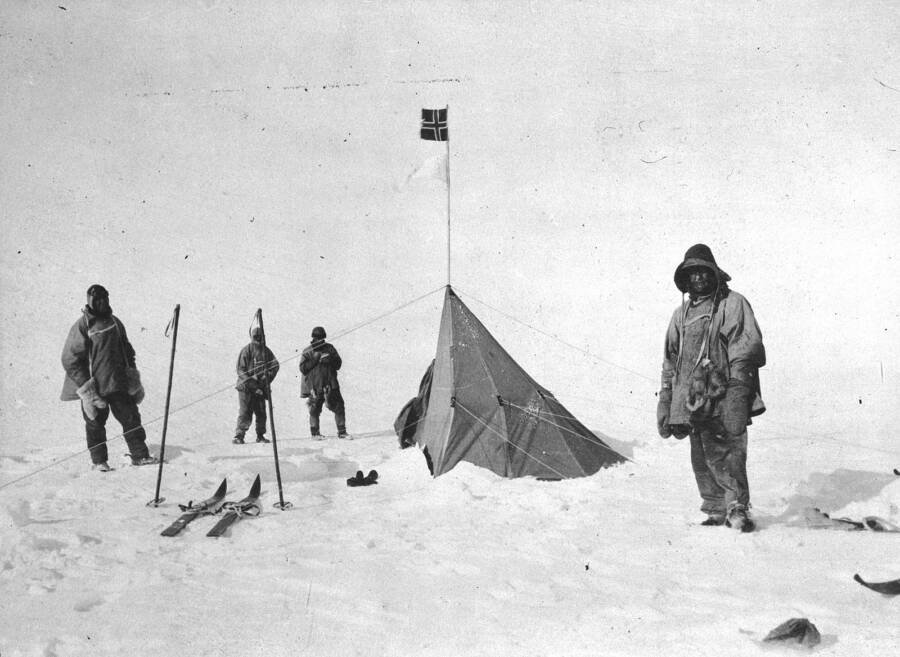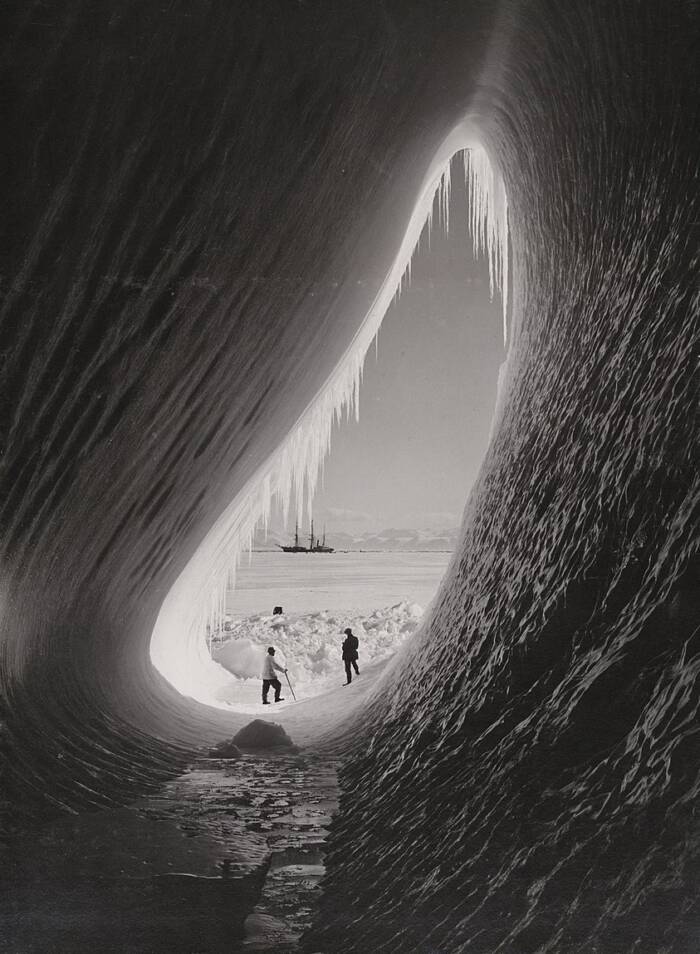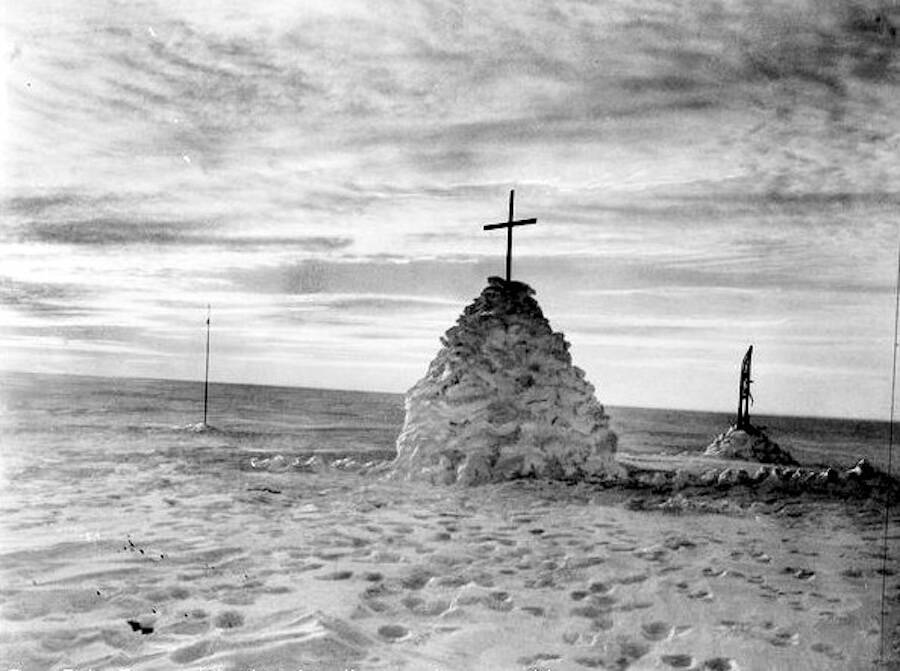The doomed Terra Nova Expedition led to the torturous deaths of British Captain Robert Falcon Scott and four of his crew members — after they failed to become the first explorers to reach the South Pole.

Wikimedia CommonsEdward Adrian Wilson, Robert Falcon Scott, Lawrence Oates, Henry Robertson Bowers, and Edgar Evans at the South Pole.
The Terra Nova Expedition is widely regarded as one of the most significant polar odysseys in history — and one of the most tragic.
In 1910, a British crew set off aboard the S.S. Terra Nova to Antarctica. For Captain Robert Falcon Scott, their objective was two-fold: to gather valuable scientific data, and to be the first people to reach the South Pole.
Unfortunately for them, another expedition crew led by Norwegian explorer Roald Amundsen would get there first. And the five Terra Nova crew members sent to the South Pole would tragically perish on the long trek back — including Scott himself.
But the mission wasn’t a complete loss. Before the polar crew died, the Terra Nova Expedition yielded hundreds of unprecedented discoveries that would forever change our understanding of the icy continent.
Trip Leader Robert Falcon Scott
Robert Falcon Scott was born June 6, 1868, in Devonport, England. He was the third of six children and had seafaring in his blood, as Scott’s grandfather and four uncles had all served in the British Royal Navy or Army.
Scott was sent to the Stubbington House school as a young boy to prepare for a Naval career of his own. He passed his entrance exams and boarded the HMS Britannia in 1881 at the age of just 13.
A shy but steady and courageous young man, Scott spent the next two decades rising in the ranks on numerous Navy expeditions around the world — from midshipman in 1883 to lieutenant in 1897.

Wikimedia CommonsScott and his men at the South Pole.
Scott was around 31 when he bumped into his former colleague Clements Markham — the president of Britain’s Royal Geographical Society — in the streets of London. Years earlier, Markham had noted Scott’s intelligence and vigor for exploration, and he informed Scott of an impending expedition to Antarctica. Scott immediately applied to lead it.
In June 1900, despite having no exploration or polar travel experience, Scott was appointed the rank of commander and selected to lead the British National Antarctic, or Discovery, Expedition.
Scott proved his mettle. During the 1901 expedition to Antarctica, he achieved the new record for the farthest point reached south of the equator and performed the first thorough exploration of the frozen continent, making major finds in biology, zoology, magnetism, and meteorology.
Upon his return to England in 1904, he was promoted to captain. But his mind was still on the Antarctic. He had nearly reached the South Pole during the British National Antarctic Expedition, and was determined to try once more.
He would get that chance in 1910 — as captain of the Terra Nova Expedition.
The Terra Nova Expedition Begins
The Terra Nova departed June 15, 1910 from Cardiff, with dozens of crew members appointed by Robert Falcon Scott. Chief among them were head scientist Edward Wilson and photographer Herbert Ponting.
The Terra Nova Expedition’s official objective was to gather scientific and geographical data. However, the real prize, at least as far as the British imagination was concerned, was in reaching the South Pole before any other nation.
The competition was a fierce one. Earnest Shackleton had recently made it 97 miles from the South Pole during his 1907-1909 expedition. Roald Amundsen, meanwhile, was departing within days of Scott on his own Antarctic expedition, spurring a race against time for the pole.

Wikimedia CommonsA grotto photographed by Herbert Ponting.
According to the Antarctic Heritage Trust, the Terra Nova‘s cargo included: 162 carcasses of mutton and three carcasses of beef; cheese and butter; three motor tractors and drums of petrol; two Siberian and 17 Manchurian ponies; 33 Siberian dogs; photo and medical supplies; as well as clothing, tools, sledging equipment, surveying instruments, coal, sleeping bags, tents, and huts.
In November 1910, according to a timeline from the Scott 100 Plymouth program, the crew lost two ponies, one dog, one sledge, and some coal and petrol in a storm before the ship even reached Antarctica.
Life At The Cape Evans Basecamp
The Terra Nova expedition arrived in January 1911 at the Ross Ice Shelf, otherwise known as the Great Ice Barrier, south of New Zealand. The crew unloaded sled dogs, ponies, and motorized sledges, set up pre-constructed huts, and began their research.
Once they established camp, First Officer Victor Campbell sailed east to King Edward VII Land. On his way back, he found Amundsen’s ship docked in the nearby Bay of Whales. After a brief greeting, Campbell rushed back to camp to inform Captain Scott that their competition had arrived.
Determined to beat Amundsen to the South Pole, Scott ordered his men to begin placing supply depots along the planned path in preparation for the journey. According to Mashable, six of the eight ponies sent on these missions died in blizzards.
As the Antarctic winter began in April, the 25 crew members stationed on land were forced to hunker down in a 50-by-25-foot hut. They busied themselves with research and soccer matches while Scott continued planning for the final push to the pole.
During this time, Wilson managed to retrieve three Emperor penguin eggs for future study, braving temperatures as low as -77 degrees Fahrenheit on the 60-mile trek to the rookery.

Wikimedia CommonsThree recovered Emperor penguin eggs.
The Treacherous Journey To The South Pole
Captain Robert Falcon Scott finalized his plans to reach the South Pole in the Arctic spring. On Oct. 24, 1911, he set out across the Great Ice Barrier with 16 men, motor sledges, dogs, and ponies. According to Scott’s plan, different members of the group would turn back after reaching specific checkpoints, ultimately leaving five men to finish the final trek to the pole.
However, the sledges broke down just 50 miles into the journey. With only dogs and a few ponies at their disposal, the group reached the end of the Great Ice Barrier on Dec. 4. When they reached the final plateau before the pole on Dec. 20, Scott sent the dogs back to base camp.
On Jan. 3, 1912, Captain Scott selected four men to join him in the final push: Edward Wilson, Lawrence Oates, Lieutenant Henry Bowers, and Edgar Evans.
The polar crew finally arrived at the South Pole on Jan. 17 — to find Amundsen’s flag already planted there.
The Norwegian explorer had beaten them by 34 days.
“The POLE. Yes, but under very different circumstances from those expected,” a dismayed Scott wrote in his diary. “Great God! This is an awful place and terrible enough for us to have laboured to it without the reward of priority.”
Defeated, the men turned around to make the deadly 900-mile journey back to base.
The Icy Deaths Of The Terra Nova Expedition Polar Crew
The crew crossed the polar plateau without much trouble. But on Feb. 17, while making the difficult climb up Beardmore Glacier, Evans collapsed from severe frostbite and other injuries — and died.
In early March, the remaining polar crew members were relieved to reach one of their supply depots on the Great Ice Barrier, where a dog team was supposed to pick them up. It never did.
Meanwhile, Oates had developed such severe frostbite and gangrene that he couldn’t hike more than a few miles a day. He lost the use of his hands by March 17. It was his 32nd birthday.
Aware that he was slowing the team down, he died by suicide, telling the crew, “I am just going outside, and I may be some time,” before leaving their tent and walking into the elements.
Scott, Bowers, and Wilson forged ahead but got caught in a blizzard in late March, just 11 miles away from a huge food and supplies depot. They tragically perished while waiting it out.
“Every day we have been ready to start for our depot 11 miles away, but outside the door of the tent it remains a scene of whirling drift,” Scott wrote in his last diary entry on March 29. “I do not think we can hope for any better things now. We shall stick it out to the end, but we are getting weaker, of course, and the end cannot be far. It seems a pity but I do not think I can write more… For God’s sake look after our people.”

Wikimedia CommonsThe grave of Robert Falcon Scott, Henry Robertson Bowers, and Edward Adrian Wilson.
Meanwhile, the surviving Terra Nova Expedition members back at camp were routinely trekking to supply depots in hopes of finding Scott and his men, but without success. They eventually organized a full-fledged search party on Oct. 29. Within two weeks, they found the frozen bodies of Scott, Wilson, and Bowers — and built a stone cairn over their corpses.
The party reportedly continued searching for Oates, but only found his sleeping bag. There is no record of what was done with Evans’ body.
The Legacy Of The Terra Nova Expedition
England was devastated by the loss of the Terra Nova crew members. But while they didn’t succeed in becoming the first people to reach the South Pole, the Terra Nova Expedition was far from fruitless.
The expedition yielded priceless scientific finds, including an estimated 2,000 animal specimens — 400 of which had never been discovered before, according to the BBC.
Chief among these specimens were the three Emperor penguin eggs Wilson had retrieved. Until that point, it was thought that these birds were descended from dinosaurs, a theory that an analysis of the embryos disproved.
What’s more, a fossil found near Scott’s body of a plant named Glossopteris indica helped prove a contemporary theory that Antarctica had once been part of a supercontinent called Gondwanaland, which had a climate warm enough to support tree growth.
Today, the Terra Nova Expedition is largely remembered for its bleak and fatal conclusion. For its members, however, it meant much more.
Before leaving Antarctica, the remaining Terra Nova crew members erected a large wooden cross at Ross Island, inscribed with a quote from Alfred Lord Tennyson’s Ulysses:
“To strive, to seek, to find, and not to yield.”
After learning about the Terra Nova Expedition, check out these stunning vintage photos of Antarctica. Then, learn about the doomed Franklin Expedition, which saw its crew members turn to cannibalism.





